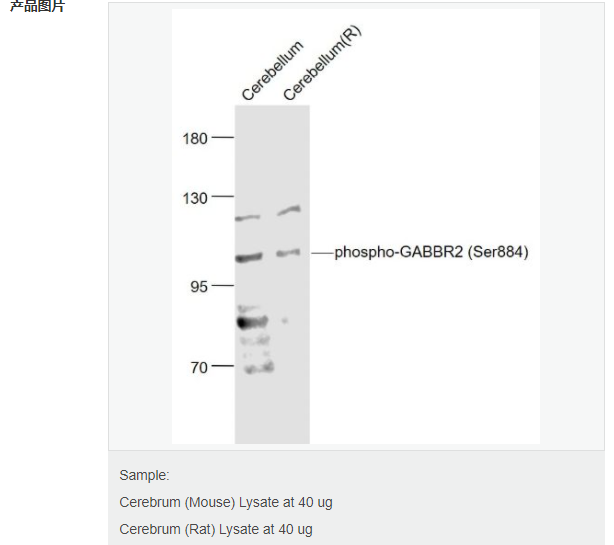
货号
产品规格
售价
备注
BN40415R-100ul
100ul
¥2470.00
交叉反应:Human,Mouse,Rat(predicted:Dog,Pig,Cow,Horse,Rabbit,Sheep,GuineaPig) 推荐应用:WB,IHC-P,IHC-F,ICC,IF,ELISA
| 英文名称 | phospho-GABBR2 (Ser884) |
| 中文名称 | 磷酸化G氨基丁酸B型受体2抗体 |
| 别 名 | GABA B Receptor 2 (phospho S884); p-GABA B Receptor 2 (phospho S884); p-GABBR2 (Ser884) ; GABBR2; GB2; G protein coupled receptor 51; G-protein coupled receptor 51; GAB B R2; GABA B R2; GABA B receptor 2; GABA B RECEPTOR; GABA-B receptor 2; GABA-B-R2; GABA-BR2; GABA[[B]]R2; GABAB R2; GABABR 2; GABABR2; GABB R2; GABBR 2; Gabbr2; GABR2_HUMAN; Gamma aminobutyric acid (GABA) B receptor 2; Gamma aminobutyric acid B receptor 2; Gamma aminobutyric acid GABA B receptor 2; Gamma aminobutyric acid type B receptor subunit 2; Gamma-aminobutyric acid type B receptor subunit 2; Gb 2; Gb2; GH07312; GPR 51; GPR51; GPRC 3B; GPRC3B; HG 20; HG20; HRIHFB2099; Metabotropic GABA B receptor subtype 2; OTTHUMP00000021776; OTTHUMP00000063797; R2 SUBUNIT; BcDNA:GH07312; CG6706; CT20836; D GABA[[B]]R2; D Gaba2; FLJ36928. |
| 产品类型 | 磷酸化抗体 |
| 研究领域 | 细胞生物 神经生物学 细胞膜受体 |
| 抗体来源 | Rabbit |
| 克隆类型 | Polyclonal |
| 交叉反应 | Mouse, Rat, (predicted: Human, Dog, Pig, Cow, Horse, Rabbit, Sheep, Guinea Pig, ) |
| 产品应用 | WB=1:500-2000 ELISA=1:5000-10000 IHC-P=1:100-500 IHC-F=1:100-500 ICC=1:100-500 IF=1:100-500 (石蜡切片需做抗原修复) not yet tested in other applications. optimal dilutions/concentrations should be determined by the end user. |
| 分 子 量 | 104kDa |
| 细胞定位 | 细胞膜 |
| 性 状 | Liquid |
| 浓 度 | 1mg/ml |
| 免 疫 原 | KLH conjugated synthesised phosphopeptide derived from human GABBR2 around the phosphorylation site of Ser884:IN(p-S)PE |
| 亚 型 | IgG |
| 纯化方法 | affinity purified by Protein A |
| 储 存 液 | 0.01M TBS(pH7.4) with 1% BSA, 0.03% Proclin300 and 50% Glycerol. |
| 保存条件 | Shipped at 4℃. Store at -20 °C for one year. Avoid repeated freeze/thaw cycles. |
| PubMed | PubMed |
| 产品介绍 | The multi-pass membrane protein encoded by this gene belongs to the G-protein coupled receptor 3 family and GABA-B receptor subfamily. The GABA-B receptors inhibit neuronal activity through G protein-coupled second-messenger systems, which regulate the release of neurotransmitters, and the activity of ion channels and adenylyl cyclase. This receptor subunit forms an active heterodimeric complex with GABA-B receptor subunit 1, neither of which is effective on its own. Allelic variants of this gene have been associated with nicotine dependence.[provided by RefSeq, Jan 2010]. Function: Receptor for GABA. The activity of this receptor is mediated by G-proteins that inhibit adenylyl cyclase activity, stimulates phospholipase A2, activates potassium channels, inactivates voltage-dependent calcium-channels and modulates inositol phospholipids hydrolysis. Plays a critical role in the fine-tuning of inhibitory synaptic transmission. Pre-synaptic GABA-B-R inhibit neurotransmitter release by down-regulating high-voltage activated calcium channels, whereas postsynaptic GABA-B-R decrease neuronal excitability by activating a prominent inwardly rectifying potassium (Kir) conductance that underlies the late inhibitory postsynaptic potentials. Not only implicated in synaptic inhibition but also in hippocampal long-term potentiation, slow wave sleep, muscle relaxation and antinociception. Subunit: Heterodimer of GABA-B-R1 and GABA-B-R2. Neither of which is effective on its own and homodimeric assembly does not seem to happen. Interacts with ATF4 via its C-terminal region. Subcellular Location: ell membrane; Multi-pass membrane protein. Cell junction, synapse, postsynaptic cell membrane; Multi-pass membrane protein. Note=Moreover coexpression of GABA-B-R1 and GABA-B-R2 appears to be a prerequisite for maturation and transport of GABA-B-R1 to the plasma membrane. Tissue Specificity: Highly expressed in brain, especially in cerebral cortex, thalamus, hippocampus, frontal, occipital and temporal lobe, occipital pole and cerebellum, followed by corpus callosum, caudate nucleus, spinal cord, amygdala and medulla. Weakly expressed in heart, testis and skeletal muscle. Similarity: Belongs to the G-protein coupled receptor 3 family. GABA-B receptor subfamily. SWISS: O75899 Gene ID: 9568 Database links: UniProtKB/Swiss-Prot: O75899.1 Important Note: This product as supplied is intended for research use only, not for use in human, therapeutic or diagnostic applications. g-氨基丁酸(GABA)是哺乳动物中枢神经系统中重要的抑制性神经递质,在体内通过作用于离子通道型的GABAA、GABAC受体及代谢型的GABAB受体而发挥生理功能。 GABAB 受体存在于神经元的突触前及突触后部位,介导慢的抑制性效应,在脑内参与许多重要的生理活动和病理变化,包括认知损害、癫痫、痉挛及药物成瘾等。 GABAB2在与GABAB1形成二聚体后可激活G蛋白,但它没有结合GABA的能力;GABAB2还可增强激动剂与GABAB1的亲和力,并且通过与GABAB1形成二聚体结构而屏蔽GABAB1的胞内滞留信号。 |
